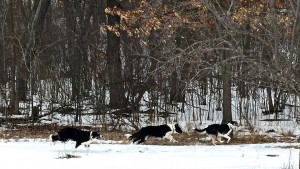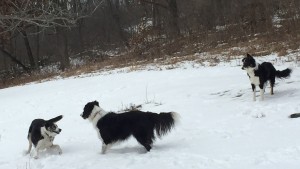Cavalier Puppy Walks Funny on Leash at Night
If there is anything harder than euthanizing a beloved dog for serious behavioral problems, I don't know what it is. And yet, sometimes, that is an option that dog owners have to consider. These were some of the hardest cases I worked with when I was seeing clients full time. I would drive home, sick at heart, and wonder why the hell I hadn't found an easier way to make a living. Often I'd run into people who would say "Oh! What a wonderful job you have!", no doubt envisioning me spending my days running through fields of daisies with Golden Retriever puppies.
 As hard as it is to talk to clients about whether to put down an aggressive dog, it is nothing compared to what the owners are going through. Euthanizing a physically healthy dog, one who is joyful and loving part of the time, is surely the hardest thing a dog lover has to face. My intention here is to help people considering the option of whether to put down a dog who is seriously aggressive, in hopes that I can provide some guidance. I'll get the conversation started, but I greatly value the input of you as a reader, if you have any to share. Let me start by asking that we agree on a definition of "canine aggression." For the sake of our discussion, let's define aggression as an action in which a person is either injured or at clear risk of being injured by a dog. We all know that a great deal of what is labeled as "aggression" is defensive behavior, but for the sake of our discussion, let's focus on consequences, and not what we think is the dog's intent.
As hard as it is to talk to clients about whether to put down an aggressive dog, it is nothing compared to what the owners are going through. Euthanizing a physically healthy dog, one who is joyful and loving part of the time, is surely the hardest thing a dog lover has to face. My intention here is to help people considering the option of whether to put down a dog who is seriously aggressive, in hopes that I can provide some guidance. I'll get the conversation started, but I greatly value the input of you as a reader, if you have any to share. Let me start by asking that we agree on a definition of "canine aggression." For the sake of our discussion, let's define aggression as an action in which a person is either injured or at clear risk of being injured by a dog. We all know that a great deal of what is labeled as "aggression" is defensive behavior, but for the sake of our discussion, let's focus on consequences, and not what we think is the dog's intent.
First and Foremost: It is No One's Decision But Your Own: This is both a blessing and a curse. Clients often asked me "What would you do if it was your dog?" I can never answer that question, because I'm not the one who will have to lie in bed at night thinking about what has happened. What I can do is start by sympathizing, and saying that I am so, so sorry that anyone is in the position of having to consider putting down a physically healthy dog because of a serious behavioral problem. It is exhausting, heartbreaking and terrifying. When I talk to people in this situation I emphasize how important it is to be kind and compassionate toward themselves, as if they were facing a serious illness. Their brain thinks they are. I ask them to surround themselves with good friends who are truly supportive, and to shake off any harsh judgements or unhelpful advice as best they can.
Usually conversations about serious behavioral problems include three primary options for dealing with all serious behavioral problems: 1) Keep the dog and work with a trainer or behaviorist to mitigate or manage the problem, 2) re-home the dog if it can be done safely and responsibly, and 3) euthanize the dog. Needless to say, option three should only be considered if options one and two are not viable. But how do you consider if they are or are not? Here are criteria that I suggest everyone consider:
1. Risk Assessment: No one begins a conversation about whether their dog should be put down for aggressive behavior if there haven't been several incidents (or one horrifically serious one). And every dog owner has to know that if "it," the aggression, happened once, it might happen again. That is true even if the dog is carefully managed and the owners work hard on a treatment plan. The question is, what is "it"? What are the consequences if "it" happens again? I was once called by a public health employee about a case in which a dog had damaged someone's face so badly it required 400+ stitches to repair. The dog had then been given away to someone else, and ended up mutilating a child's face, arm and shoulder. Would it be possible, I was asked, to work with the dog and make it safe? Yes, perhaps… anything is possible. But there is always a risk that it might happen again, and in this case, "it" was a horrific injury to an innocent person. Who would be willing to risk that kind of damage to another person. Of course, a seriously dangerous dog could live in a cage with extremely limited social contact, but that brings up the issue of quality of life (which I'll discuss later on in this piece).
On the other hand, if "it" happening again means that your dog has growled at someone, then you might be in a very different conversation. Growls and snaps to people aren't acceptable either, but just because a dog growls at the delivery man when she's ten months old doesn't mean she is going to be a dangerous dog. There are lots of dogs who can be turned around, or at least managed, as long as the owners acknowledge that the behavior needs addressing, and can find good advice about how to do so.
Thus, anyone in a conversation about euthanizing an "aggressive" dog has got to ask themselves two risk-related questions: First, if the injury was to another person, what risk does your dog pose to others? How would you feel if your dog put someone in the hospital? Second, what are the consequences to you? What is your legal risk if there is another incident? Are you willing to lose your home owner's insurance? Defend yourself in a lawsuit? If the bite was to you, can you spend a year healing your hand from a bad bite that keeps you from writing, or playing the violin as a musician? In addition, and essentially, everyone has a different tolerance for risk. Can you live in health knowing that your dog might badly injure someone if you forget to lock a door? Some people are fine with a background level of risk, and in addition have little trouble following a rigid routine to keep things safe. Others aren't. Owners have to ask themselves which category they fall into.
2. Do you have the resources required to a) manage the dog so that everyone stays safe, and b) work on a treatment plan? Loving a dog is not the same as having the knowledge or logistical ability to treat a serious behavioral problem. Love, I'm afraid, is not always "all you need." I have seen innumerable clients who loved their dog, but who simply didn't have the emotional or logistical ability to manage and treat a serious aggression problem. As much as I want to help save as many dogs as I can (my training business was named "Dog's Best Friend" after all), I feel tremendous empathy for people who, through no fault of their own, simply can't cope anymore. Perhaps they have been living in fear of their dog for years and are emotionally exhausted. I saw hundreds of people in that category: women who were terrified that their dog would turn on them with no warning, as it had in the past; men who lived in fear that their dog would bite another neighbor and the lawsuit would destroy a lifetime of hard work. It is easy for some to dismiss such people, and argue that they themselves would never give up on a dog, no matter what the dog had done. But be careful of making judgments here: I have seen people whose lives were almost destroyed because of an aggressive dog. People who hadn't had company for over a decade and whose marriages were on the rocks (or over) because of it. A woman whose dog stalked her through the house and held her hostage in the upstairs bedroom at midnight while I and a colleague drove up outside to capture the dog and save her. One of my clients stitched up a long, serious bite wound in fear that getting medical care would force her to consider not keeping her dog.
3. Can the dog be re-homed? Aggression is often context specific, and if it is triggered by predictable, and manageable stimuli, then the dog might indeed be able to be re-homed. Perhaps the dog is only dangerous around children, and the current owner has three young ones. A home might be found that doesn't include children. BUT… and this is crucial: Just because the new owners don't have young children doesn't mean the dog won't be exposed to them. What about neighborhood walks? What about visiting grandchildren? This scenario can work, I've seen it work many a time, but the new owners absolutely have to be clear that no, just because the dog seems so sweet to them doesn't mean it will be equally sweet to children. The new owners must understand that the dog has to learn to go into a crate, in a closed room, if kids come to visit. Perhaps the dog only goes outside into the backyard instead of being leash-walked in a neighborhood with children. All these details depend on the facts of the case, but what never varies is that responsible re-homing is dependent upon the risk assessment discussed above, and an objective, clear-eyed evaluation of what is required to keep people safe around the dog.
Free to a good home in the country? Oh, how often I have heard that. Yes, it is true that some dogs do much better outside of a neighborhood or city environment. I have had numerous cases of dogs who thrived in a different setting than the one in which the aggression occurred. However, you must keep this in mind: People who live in the country are not hermits. We have visitors of all age, shapes and sizes. We have delivery men who pull up in noisy trucks and leave as soon as the dog barks, often more than city dwellers. We have hay delivered, the LP tank filled, and the meter read. We have feral cats and wanderings dogs who show up when you least expect them and have no time to cope. Thus, yes, there are some cases in which dogs can be safe and happy in a rural setting instead of an urban or suburban one. But it is not a panacea, and the details of the case are crucial to making it work, or not.
Is there another home out there? This can be the heart breaker. Just because it is possible for a dog to be rehabilitated in a specific type of environment doesn't mean that it is available. How many people can cope with a dog who has a history of serious aggression to people? How many prospective owners have the skills and a life that makes it possible for them to do so? Finances must also be considered. Any aggressive dog should have extensive veterinary work to ensure that illness or pain isn't causing the behavior. In addition, working with a trainer or behaviorist can be expensive. There are indeed people who are able and qualified to take on a dangerous dog–some of whom read this blog, bless them. I have taken on a few dogs in my own home myself. But there simply aren't enough people out there who are willing and able to take on an aggressive dog, and the number of dogs who need a new home far, far out number the homes available to them.
4. Quality of life for the dog. What about the dog? I've worked with dogs so fearful of ___ (fill in the blanks) that they were clearly suffering for much of their life. What of the dog whose only joy in life is going to the dog park, but is dangerous around any and all strangers? What of the dogs who have unpredictable aggressive episodes that may or may not be reflective of some kind of untreatable electrical storm in their brain? The question about quality of life for dogs with serious behavioral problems is just as important as it is for dogs with physical problems. (See here for a great blog about when to put down a sick or old dog.) This is another question that only the owners can answer, but in this case it is important to get an objective opinion. I'd advise someone who comes into your home and observes the dog there. Behavior at home isn't always obvious when a dog is outside of the house, so try to have your friends or a behaviorist, veterinarian or trainer help you here.
I want to circle back to where I started: Yes, of course, there are people who have dogs euthanized with less thought and consideration than we would like. But there are many loving, responsible dog owners who have had to face this soul-scorching decision who have agonized over it. They deserve our sympathy. No one makes this more clear than my friend and colleague Phyllis D, who wrote about the difficult decision to put her dog down because of its aggressive behavior. She still gets comments about it, as do I in a post I wrote titled Love, Guilt and Putting a Dog Down. If you have anything to add that you think might help someone in this position, I'd be grateful if you added in your comment. If you are or have had to face this decision, I am so sorry. Know that no matter how smart and hard-working and dedicated and dog-loving and responsible we humans are, we can't always fix everything. A tough thing for us all to accept. While you try to do so, take care of yourself.
MEANWHILE, back on the farm: A much happier place than the conversation above! We are beyond sick of winter here, but take our joys when we can. This weekend Willie and Maggie got to play with Max, a new friend to Maggie and an old one to Willie, although we lost touch for a few years with the owners. Max is a six-year old Border Collie who is equally squishy and sweet to people and dogs alike. He loves to play "race horse," Willie and Maggie's favorite game, and we got to watch the three dogs run and run and run in huge, yard-gulping circles around the fields.
 Willie and Max also love to play in a way that Maggie doesn't: Both of the boys think it is great fun to lunge toward the other to stop their forward progress. "Ha! Smashed you in the face! Isn't that fun?" I consider it a highly inappropriate play behavior from Willie, and was interested when Max did it back to him.
Willie and Max also love to play in a way that Maggie doesn't: Both of the boys think it is great fun to lunge toward the other to stop their forward progress. "Ha! Smashed you in the face! Isn't that fun?" I consider it a highly inappropriate play behavior from Willie, and was interested when Max did it back to him.

Hmmm, I thought, how will Willie feel about being on the receiving end? I watched it happen with a bit of concern, but Willie appeared to be thrilled that yet another dog knew how to play the best game ever! Maggie response was along the lines of: "Well, if you're going to play like that I'll just stay over here." Thus, all three dogs run and run and run, but you can see from the photos that Willie and Max are the primary play partners, and Maggie is the third dog out. Exactly as she wants it!
I had hoped to get some photos of the wild turkeys that have been all over the fields lately, no doubt coming out of the woods in search of new food sources. But of course, when I had my camera the turkeys were no where to be seen, but when I went in search of them I ran across a huge group of Canada Geese settled on a field. Lovely animals (although pests in some contexts).
Can you see from these photos how very black, white and brown our world is right now? And why we are all so starved for color? Will we see tiny green shoots in a month or so? Oh, how beautiful that will be. It's hard to imagine how sweet a quarter inch of green can be until you've lived through five months of black and white.

Source: https://www.patriciamcconnell.com/theotherendoftheleash/when-is-it-time-to-put-down-a-dog-who-is-aggressive-to-people
0 Response to "Cavalier Puppy Walks Funny on Leash at Night"
Enregistrer un commentaire